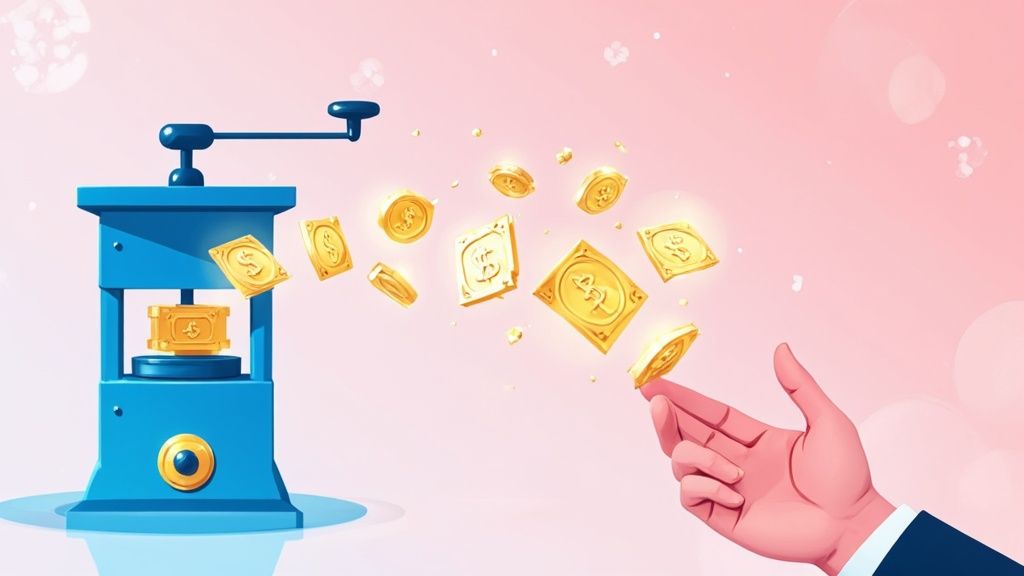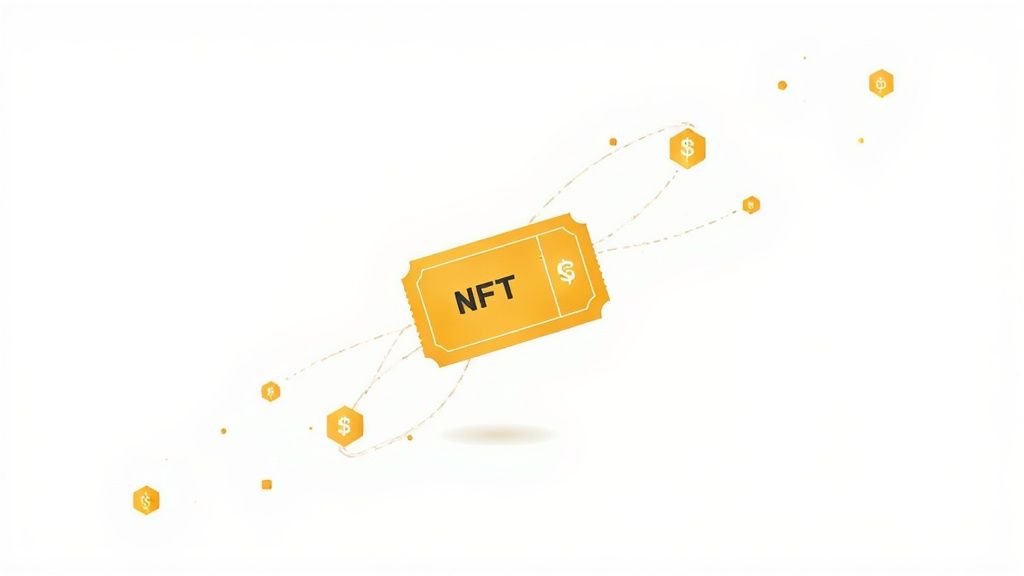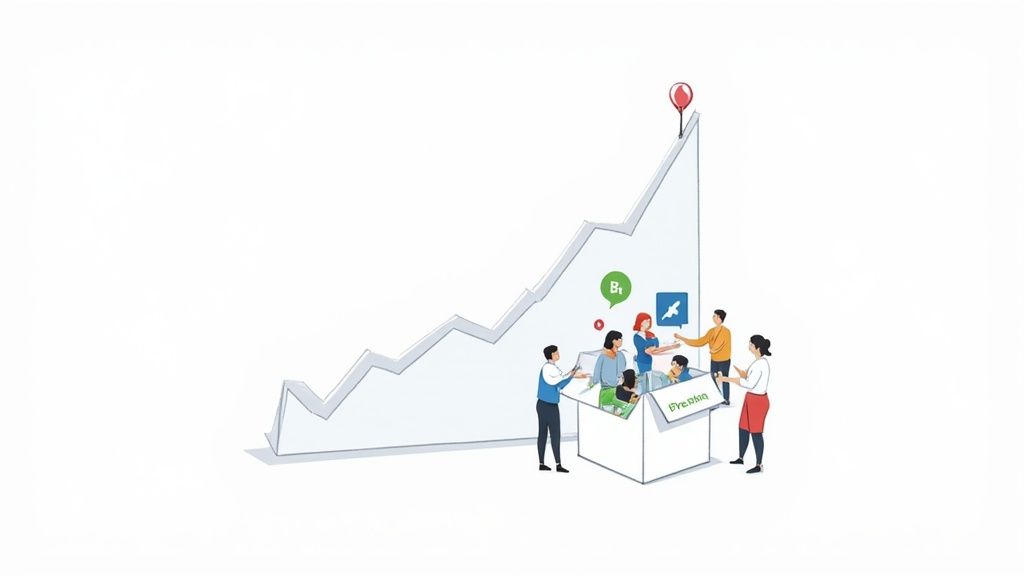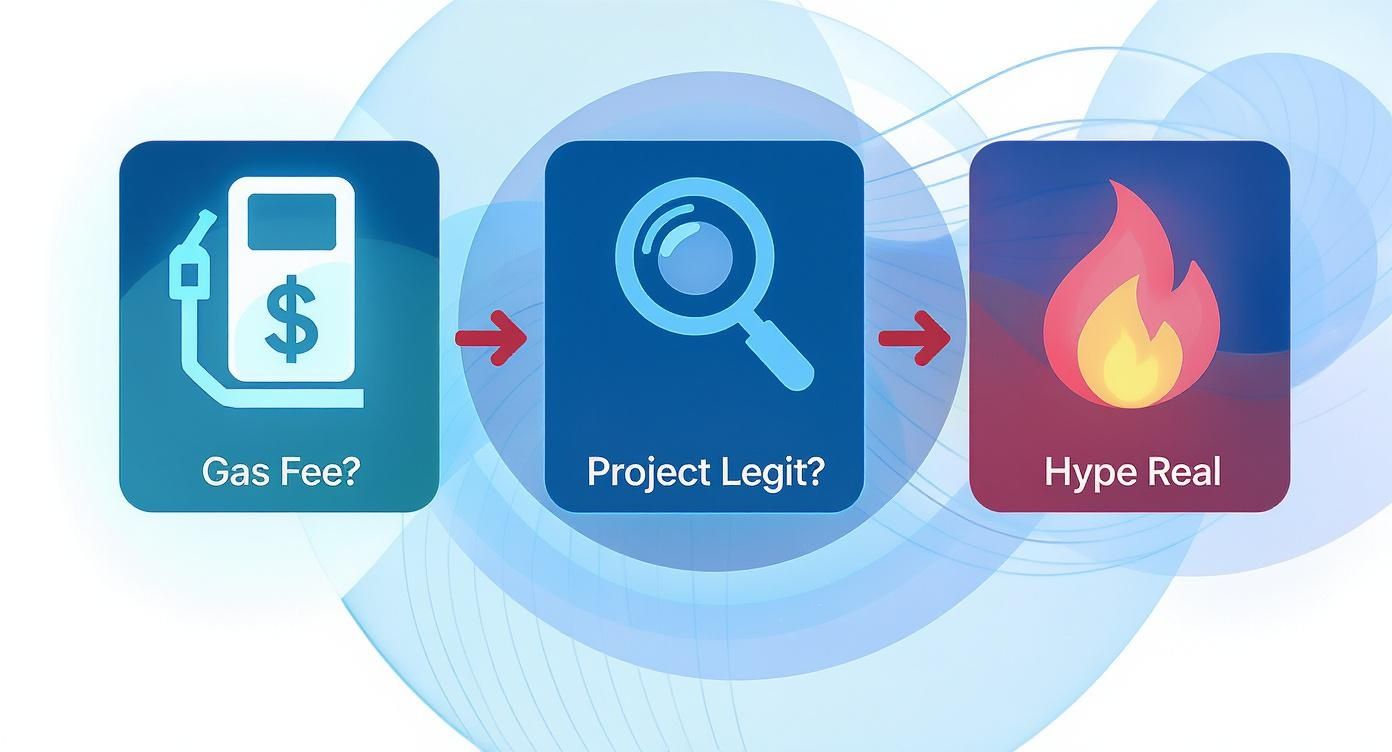Your Guide to the Free Mint NFT Revolution

You’ve probably seen the term "free mint NFT" buzzing around and thought, "Free? What's the catch?" It's a fair question. A free mint is a digital collectible you can claim without paying the project creator a dime. However, you still have to cover the network transaction cost, which is widely known as a gas fee.
It’s a bit like getting a free ticket to a show online. The ticket itself doesn’t cost anything, but you still have to pay a small service fee to the platform that processes the order. This approach makes it way easier for newcomers to get into the NFT space and has become a super popular launch strategy.
So, What's a Free Mint NFT, Really?

When an NFT is a "free mint," the "free" part is about the digital art or asset itself. The creators are essentially giving it away. But the blockchain network that powers it all still needs to be paid for its work.
Every single action on a blockchain, from sending crypto to a friend to minting a new NFT, uses up computing power. That power isn't free. The network charges a gas fee to pay the people (or computers) who validate transactions and keep everything secure. This fee is unavoidable and is the only real cost you’ll face with a free mint.
How Is This Different from a Paid Mint?
With a typical paid mint, you're hit with two costs: the price the project sets for the NFT and the gas fee for the blockchain. A free mint just gets rid of that first cost, leaving you with only the gas fee to worry about.
This makes it a fantastic way for people who are curious about NFTs to dip their toes in the water without risking a bunch of money on a project that's just starting out. The creators are playing the long game here. They're betting that by giving the NFTs away, they can build a huge, passionate community that adds value over time through trading on the secondary market.
The whole point of a free mint is to knock down that initial paywall. It’s a shift from making a quick buck on the initial sale to focusing on community growth and long-term potential. Creators usually plan to make their money from royalties on future sales, not the mint itself.
Let's quickly compare the two models side-by-side to make it crystal clear.
Free Mint vs Paid Mint A Quick Comparison
This table breaks down the main differences you'll encounter when deciding whether to jump into a free mint or a paid one.
| Feature | Free Mint NFT | Paid Mint NFT |
|---|---|---|
| Upfront Cost | Only pay the network gas fee | Pay the project's mint price + gas fee |
| Primary Goal | Build a large, engaged community quickly | Generate initial revenue for the project |
| Risk for Collector | Lower financial risk, mostly time & gas | Higher financial risk, paying for an unproven asset |
| Creator's Revenue | Primarily from secondary market royalties | A mix of upfront mint sales and royalties |
As you can see, the free mint model is all about accessibility and community, while the paid model is a more traditional way to fund a project from the get-go.
The Two Pieces of the Puzzle
When it comes down to it, any NFT mint has two key components: the actual token (the NFT) and the transaction (the minting process). If you want to dive deeper into the basics, our guide on tokens in cryptocurrency is a great place to start.
For a free mint, it looks like this:
- The NFT (Token): The digital collectible is given to you for $0 by the project creators.
- The Transaction (Mint): You must pay the blockchain a variable gas fee to process the transaction and officially record you as the owner.
This simple but effective model has become the go-to launchpad for countless new NFT collections.
So, Why Bother With a Free Mint?

If the NFT is free, what's the catch? It's a fair question. But a free mint NFT isn't really a giveaway—it's one of the most powerful marketing moves in Web3. Projects use this approach to skip the hard sell and go straight to building a huge, buzzing community from day one.
Think of it like a new app offering a free version. The idea is to get a massive number of people in the door, using it, and talking about it. For an NFT project, this creates instant momentum and helps the collection catch fire on social media.
It's All About Community First
By ditching the price tag, projects drop the barrier to entry down to just the gas fee. This can flood the project with thousands of early supporters who now have a real stake in its future. Suddenly, you have a massive, built-in marketing team.
A free mint flips the script from quick cash to long-term value. Founders are betting on the community they're building, not just the initial sale.
This whole strategy really hinges on a few key things working together:
- Explosive Community Growth: Getting a ton of holders fast is the name of the game for visibility.
- Viral Hype: A fired-up community naturally spreads the word on social media, creating organic buzz that money can't buy.
- Future Paydays: The real money isn't from the mint. It's planned to come from royalties on secondary market sales down the road.
For a lot of creators, the long game is earning a small cut—usually 5-10%—every single time one of their NFTs is resold on a marketplace like OpenSea. A big, active community drives a high volume of these secondary sales, which can end up generating way more income than a one-and-done paid mint ever could. It's a growth-hacking mindset, and you can see similar ideas in action by looking at marketing automation best practices in other industries.
Of course! Here's the rewritten section with a more natural, human touch:
The "Free" in Free Mint Isn't Always Free
Let's be real for a second. When you hear "free mint," it's easy to think you're getting something for nothing. But in the world of crypto, "free" usually comes with a catch.
The most obvious cost you can't escape is the network gas fee. This is what you pay to the network validators to process your transaction on the blockchain. Think of it like a shipping fee for your NFT.
During a hyped-up free mint, it's like a digital Black Friday sale. Thousands of people all try to check out at once, clogging up the network. This demand spike sends gas fees through the roof. It's not unheard of to see gas fees jump to $50 or more just to claim one of these "free" NFTs. Suddenly, your freebie is more expensive than a regular paid mint.
Watch Out for More Than Just Gas Fees
Beyond the network costs, the free mint space can feel a bit like the Wild West. It's a magnet for scams and half-baked projects that can leave you with a completely worthless token.
There are two major pitfalls you absolutely need to watch for:
- Rug Pulls: This one is as bad as it sounds. A team hypes up a project, gets thousands of people excited, and then a flood of mints (and gas fees) comes in. Once they've created a stir, they vanish—poof. The website goes down, the Discord server is deleted, and everyone is left holding a useless JPEG.
- Zero-Effort Projects: A lot of free mints are just quick cash grabs. They have no real plan, no utility, and no community-building in mind. After the initial minting frenzy dies down, the project goes silent, the trading volume disappears, and the NFT's value flatlines. That gas fee you paid? Gone for good.
I always tell people to think of a free mint like a lottery ticket. The cost of entry is low, but the chance of it actually being valuable long-term is pretty slim. You have to go into it with your eyes wide open and a healthy dose of skepticism.
At the end of the day, the biggest risk is spending your hard-earned ETH on gas for an NFT that ends up being a ghost in your wallet. The key is learning how to spot the red flags before you even think about connecting your wallet and clicking that mint button.
How to Find and Evaluate Free Mint Projects
Diving into the world of free mint NFTs can feel a bit like treasure hunting without a map. Cool projects can pop up and vanish in the blink of an eye, but the real secret is just knowing where to look. For the most part, your main hunting grounds will be Twitter and Discord—the unofficial town squares of Web3.
On Twitter, start following influential NFT analysts and "alpha" groups. These accounts are often the first to drop intel on upcoming mints. At the same time, make a habit of joining the Discord servers for any project that catches your eye. This is where you'll get the real-time updates, feel out the community's vibe, and maybe even snag a spot on the allowlist. Don't forget about dedicated NFT calendar websites, either; they're great for seeing a bunch of mint dates all in one place.
Separating Gems from Junk
Okay, so you've found a promising free mint. Now what? Before you rush in, you've got to do a little homework. Just jumping in blind is a surefire way to waste your gas fees on a project that's going nowhere.
Think of it like a quick background check. Here are a few things I always look at to avoid the common traps:
- Vet the Team: Who's behind the project? Are the founders public about their identities (doxxed), or are they hiding behind anonymous profiles? A team with a solid reputation or a clear, professional presence is always a good sign.
- Analyze the Art and Utility: Is the art actually interesting and unique, or does it look like a cheap knockoff of a more famous collection? Even more importantly, does the NFT do anything? Is there a purpose or utility beyond just being a cool profile picture?
- Check Community Engagement: Pop into their Discord and scroll through their Twitter mentions. Are people having real conversations, or is it just a wall of bots spamming "LFG!"? Genuine excitement involves actual discussion about where the project is headed.
- Review the Roadmap: A solid project will have a roadmap that lays out its future plans clearly and realistically. If it's super vague or promises the moon with no real plan to get there, that's a huge red flag.
The NFT space is growing like crazy. Between 2021 and 2025, global awareness of NFTs shot up from 20% to 65%, which shows just how comfortable people are getting with blockchain tech. This explosion of interest means you have to be extra careful, as a lot of new people are jumping in. You can discover more insights about the NFT market's growth to get the bigger picture.
This decision tree gives you a great visual of the questions you should be asking before you decide to mint.

At the end of the day, a successful free mint isn't just about the low cost. It's about spotting a project with solid fundamentals and a strong community behind it. Of course, to even participate, you'll need some crypto in your wallet. Our guide on how to buy decentralized crypto can walk you through getting set up.
So, What's the Vibe in the Market Right Now?
Let's be real: the "gold rush" days of free mints are over. That wild, anything-goes era where just slapping the word "free" on a project guaranteed a feeding frenzy? It's cooled down, a lot.
The market has wised up. A ton of collectors got burned by projects that promised the world but delivered nothing more than a worthless JPEG. Rug pulls and low-effort cash grabs have left people skeptical, and for good reason. Now, that "free" price tag just doesn't hit the same.
The big takeaway is that a successful free mint needs way more than just a zero-dollar price. It needs a real team, a clear plan, and a reason for people to stick around after the initial drop.
Collectors Are Getting Wiser
These days, savvy collectors are treating a free mint NFT less like a free-for-all and more like an early-stage bet. They’re not just aping in anymore; they're doing their homework, asking the hard questions, and demanding to see what's under the hood.
This puts the pressure squarely on the creators. Before anyone is willing to even spend gas money, they want to see some solid fundamentals:
- A Real Team: Who's behind this? Anonymity is a huge red flag now. People want to see doxxed founders or at least a team with a proven track record.
- A Clear Roadmap: "Trust me, bro" isn't a roadmap. Collectors want to see a clear, believable plan for what comes next.
- An Actual Community: Is the Discord just filled with bots spamming "WEN MINT?" or are real people having genuine conversations? The difference is everything.
We're even seeing a bit of a negative trend lately, mostly because so many recent free NFTs have fizzled out. If you want to dive into the numbers and get the full picture, you can read the full market update analysis right here. Understanding this context is key to setting realistic expectations for any new project.
Where Are Free Mints Headed?
Free mints aren't just a flash in the pan; they're quickly becoming a core part of how Web3 projects grow and find their audience. I see them as the main welcome mat for people who are new to the space. It’s a zero-risk way to get your hands on a digital asset and see what this whole ownership thing is all about. This easy entry point is exactly what we need to get the next wave of people into Web3.
But let's be real, the future isn't just about giving away a cool PFP. The projects that stick around will be the ones that build real utility into their free mints.
More Than Just a Pretty Picture
The game is changing. Successful projects are already moving past the "collectible-only" phase and are focused on creating deeper experiences for their holders.
- Metaverse-Ready: Think NFTs that double as a key to an exclusive virtual hangout or a usable item in a game.
- A Say in the Future: Many projects now give NFT holders actual voting power, letting the community steer the ship.
- Your Digital Passport: An NFT can act as your verified identity, letting you seamlessly connect to different apps and platforms.
The big shift here is from a quick flip to a long-term membership. Your free mint NFT is becoming less of a collectible and more of a key to a digital club—one that unlocks value and experiences for years to come.
As the market gets smarter, so do the tools and security. The blockchain's transparency helps cut down on scams, making NFTs a more secure thing to own. With the NFT market hitting $36.18 billion in 2024 and still climbing, you can bet that the free mint will remain a go-to strategy for projects wanting a piece of that pie. If you want to dive deeper into the numbers, you can explore the complete NFT market forecast to see just how big this is getting.
Got Questions? We've Got Answers
Still feeling a bit hazy on the details? No problem. Let's tackle some of the most common questions people have about free mint NFTs so you can jump in with your eyes wide open.
Are Free Mint NFTs Actually Free?
Not entirely, and this is a crucial point. While the project team isn't charging you for the NFT itself, you still have to pay the blockchain's network fee, known as a gas fee, to make the transaction happen. Think of it like a shipping fee for your digital item—it goes to the network operators (validators), not the creator. Be warned: during a popular mint, these fees can sometimes get surprisingly high.
So, Can You Actually Make Money on These Things?
The short answer is yes, it's possible. If you mint an NFT from a project that explodes in popularity, its value can skyrocket. You could then flip it on a secondary marketplace for a nice profit. But let's be real: the vast majority of free mint NFT projects fade into obscurity and never gain any significant value.
What's the Single Biggest Risk I Should Know About?
Honestly, it's the scams. The biggest dangers are "rug pulls"—where the founders hype up a project, collect a ton of money from gas fees, and then vanish without a trace. Beyond outright scams, you also have to watch out for low-effort projects that have no real plan or long-term vision, leaving you holding a worthless digital token.
Ready to build a thriving Web3 community without the coding headache? Domino lets you launch engaging, reward-based quest campaigns in minutes. Automate tasks, verify participation, and watch your project grow. Get started with Domino today!
Level Up Your dApps
Start using Domino in minutes. Use automations created by the others or build your own.
